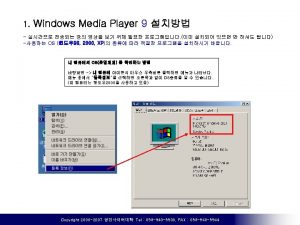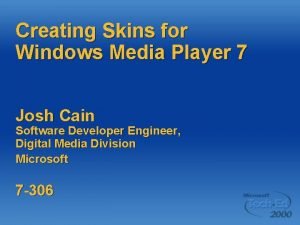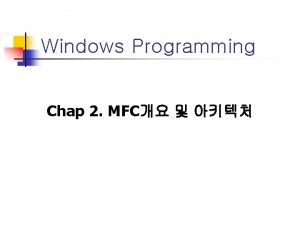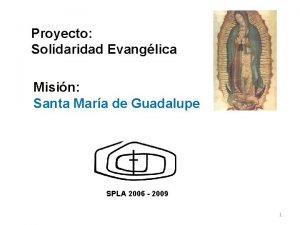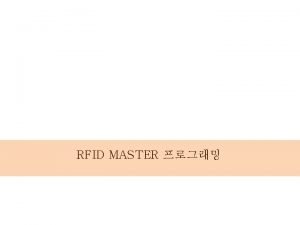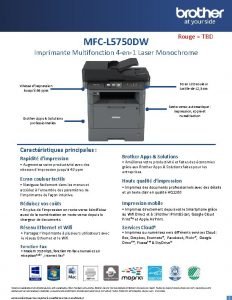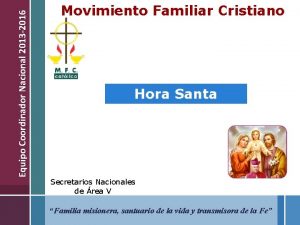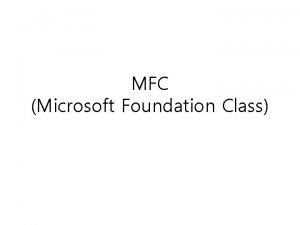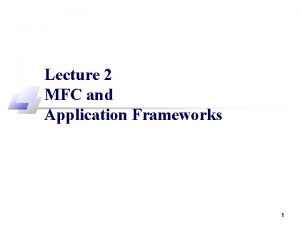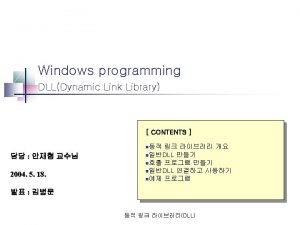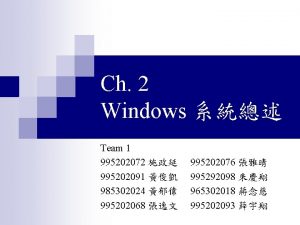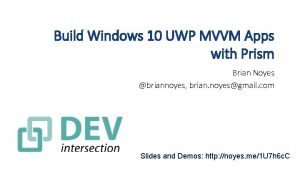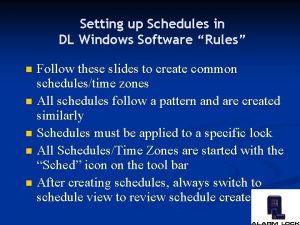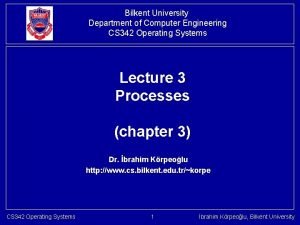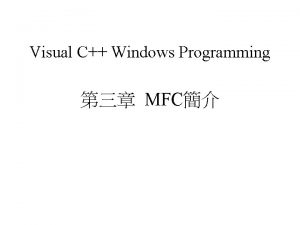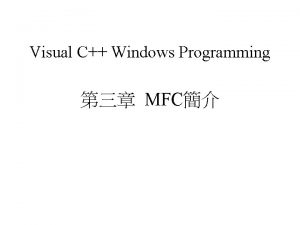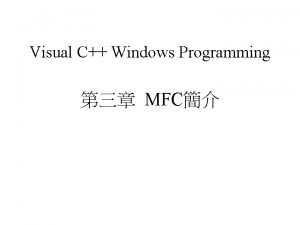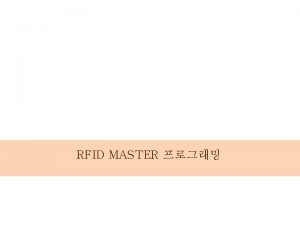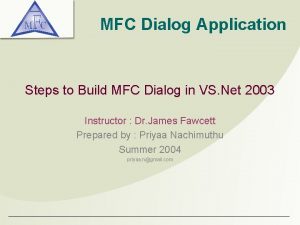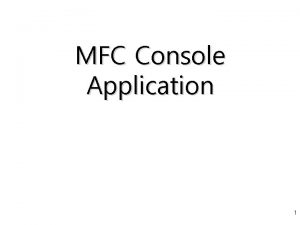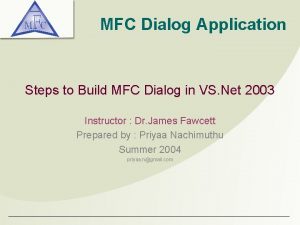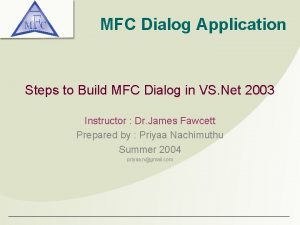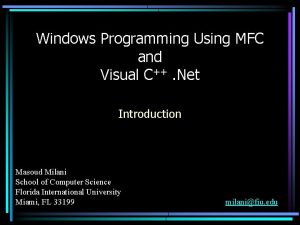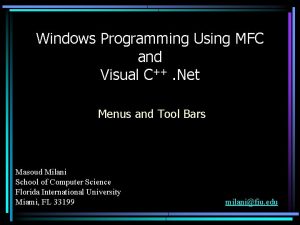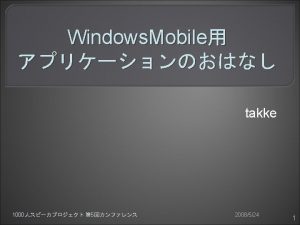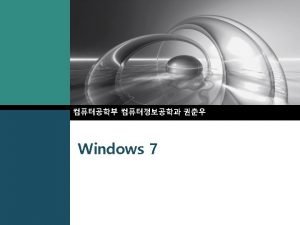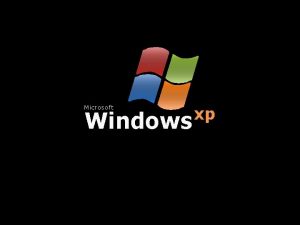q MFC Windows 2Jeff Prosise q Visual CDavid
















































- Slides: 48






相关参考书 q. MFC Windows 程序设计(第 2版)Jeff Prosise著; q. Visual C++技术内幕(第四版)David J. Kruglinski著 q深入解析MFC George Shepherd,Scot Wingo 著 q深入浅出MFC(第二版)侯俊杰(侯捷)著 6














句柄(HANDLE) 20




Win. Main函数 2 -1 q在Windows应用程序中main()被Win. Main() 取代 q. Win. Main函数的原型 int WINAPI Win. Main( HINSTANCE h. Instance, HINSTANCE h. Prev. Instance, LPSTR lp. Cmd. Line, int n. Cmd. Show ); #define WINAPI FAR PASCAL //修饰符WINAPI 代表_stdcall 24 //当前实例句柄 //上一个实例句柄 //传递给应用程序的参数字符串 //窗口显示状态

Win. Main函数 2 -2 #include <windows. h> /*定义了Windows的所有数据类型、函数调用、 数据结构和符号常量*/ int WINAPI Win. Main( HINSTANCE h. Instance, HINSTANCE h. Prev. Instance, LPSTR lp. Cmd. Line, int n. Cmd. Show) { if (h. Prev. Instance){ Message. Box(NULL, "程序已经运行", "提示", MB_OK |MB_ICONINFORMATION); return 0; } Message. Box(NULL, "Hello World", "提示", MB_OK); } 25


WNDCLASS结构体 3 -1 q 通过WNDCLASS结构体变量设计窗口,指定窗口 的属性(光标,图标,菜单,背景色等) typedef struct _WNDCLASS { UINT style; WNDPROC lpfn. Wnd. Proc; int cb. Cls. Extra; int cb. Wnd. Extra; HINSTANCE h. Instance; HICON h. Icon; HCURSOR h. Cursor; HBRUSH hbr. Background; LPCTSTR lpsz. Menu. Name; LPCTSTR lpsz. Class. Name; } WNDCLASS, *PWNDCLASS; 27 // 窗口风格 // 窗口过程 // 指定该结构的额外字节数 // Windows内部保存窗口时预留空间 // 进程句柄 // 应用程序图标句柄 // 应用程序光标句柄 // 背景画刷句柄 // 菜单资源名 // 窗口类名



设计窗口类代码 int WINAPI Win. Main (HINSTANCE h. Instance, HINSTANCE h. Prev. Instance, LPSTR lp. Cmd. Line, int n. Cmd. Show){ HWND hwnd ; // 窗口句柄 WNDCLASS wndclass ; // 窗口类 wndclass. style = CS_HREDRAW | CS_VREDRAW ; wndclass. lpfn. Wnd. Proc = Wnd. Proc ; wndclass. cb. Cls. Extra = 0 ; wndclass. cb. Wnd. Extra = 0 ; wndclass. h. Instance = h. Instance ; wndclass. h. Icon = Load. Icon (NULL, IDI_APPLICATION) ; wndclass. h. Cursor = Load. Cursor (NULL, IDC_ARROW) ; wndclass. hbr. Background = (HBRUSH) Get. Stock. Object (WHITE_BRUSH) ; wndclass. lpsz. Menu. Name = NULL ; wndclass. lpsz. Class. Name = “Hello. Win”; // 窗口类名 //以下代码省略 } 30

注册窗口类-Register. Class q设计完WNDCLASS后,需调用Register. Class 函数对其进行注册,经过注册之后,才可 以创建该窗口 q函数的原型: q. ATOM Register. Class( CONST WNDCLASS *lp. Wnd. Class // class data ); q返回值为 0代表注册失败 31

创建窗口——Create. Window 2 -1 q 设计好了窗口类并且将其注册好以后就可以用 Create. Window函数产生这种类型的窗口了 q Create. Window函数原型如下: HWND Create. Window( LPCTSTR lp. Class. Name, // registered class name LPCTSTR lp. Window. Name, // window name DWORD dw. Style, // window style int x, // horizontal position of window int y, // vertical position of window int n. Width, // window width int n. Height, // window height HWND h. Wnd. Parent, // handle to parent HMENU h. Menu, // menu handle or child identifier HINSTANCE h. Instance, // handle to application instance LPVOID lp. Param // window-creation data ); 32


显示创建的窗口 2 -1 q函数Show. Window和Update. Window分别表示 显示和刷新窗口,其函数原形分别如下: BOOL Show. Window( HWND h. Wnd, // handle to window int n. Cmd. Show // show state ); BOOL Update. Window( HWND h. Wnd // handle to window ); 34




消息循环 3 -3 //Win. Main函数 //…以上代码省略 MSG msg; while (Get. Message (&msg, NULL, 0, 0)) { Translate. Message (&msg) ; // 转换某些键盘消息 Dispatch. Message (&msg) ; } return msg. w. Param; //…以下代码省略 38


回调函数 2 -2 LRESULT CALLBACK Wnd. Proc (HWND hwnd, UINT message, WPARAM w. Param, LPARAM l. Param) { switch (message) { case WM_LBUTTONDOWN: Message. Box (NULL, “Hello World”, “问候”, 0) ; return 0 ; case WM_CHAR: char message[100]; sprintf(message, "your enter char is: %c", w. Param); Message. Box(hwnd, message, "提示", 0); return 0; } return Def. Window. Proc (hwnd, message, w. Param, l. Param) ; // 执行默认的消息处理 } 40



常用的Windows标准消息 操作 键盘键入 WM_CHAR 鼠标移动 WM_MOUSEMOVE 鼠标左键按下 WM_LBUTTONDOWN 鼠标右键松开 WM_RBUTTONUP 窗口创建 WM_CREATE 窗口销毁 WM_DESTROY 窗口关闭 WM_CLOSE 窗口显示 WM_SHOWWINDOW 窗口激活 WM_ACTIVE … 43 消息名 …



Windows程序的“生死存亡” 3 -3 //Wnd. Proc函数 //…以上代码省略 switch(u. Msg) { case WM_CLOSE: if (IDYES==Message. Box(hwnd, "确认要退出吗?", "提示", MB_YESNO | MB_ICONQUESTION)){ Destroy. Window(hwnd); } break; case WM_DESTROY: Post. Quit. Message(0); break; case WM_CREATE: Message. Box(hwnd, “first", "提示", 0); break; }//…以下代码省略 46


 Jeff prosise
Jeff prosise Jeff prosise
Jeff prosise Microsoft windows movie maker windows 7
Microsoft windows movie maker windows 7 Windows xp virtual machine download free
Windows xp virtual machine download free Windows media player 9 for windows 10
Windows media player 9 for windows 10 Jake oshins
Jake oshins Media player skins
Media player skins Nokia lumia 920 windows 10
Nokia lumia 920 windows 10 Windows live mail windows 8
Windows live mail windows 8 Windows identity foundation windows 10
Windows identity foundation windows 10 Movie maker 2012
Movie maker 2012 Windows driver kit windows 7
Windows driver kit windows 7 Windws update
Windws update How to use windows live movie maker
How to use windows live movie maker Ipseq
Ipseq Guia del matrimonio promotor mfc primer nivel
Guia del matrimonio promotor mfc primer nivel Mfc internals
Mfc internals Exigencias basicas del mfc
Exigencias basicas del mfc Mfc feature pack
Mfc feature pack Mfc cmas
Mfc cmas C++ mfc 예제
C++ mfc 예제 Cual es el carisma del mfc
Cual es el carisma del mfc Decalogo del dialogo en equipo mfc
Decalogo del dialogo en equipo mfc 6 exigencias basicas del mfc
6 exigencias basicas del mfc Mfcl5750
Mfcl5750 Oracion del espiritu santo mfc
Oracion del espiritu santo mfc P$drawbitmap
P$drawbitmap Mfc 원 그리기
Mfc 원 그리기 Mapstruct cannot find implementation for
Mapstruct cannot find implementation for Hora santa por las familias mfc
Hora santa por las familias mfc Mfc 표 만들기
Mfc 표 만들기 Taller de metodologia mfc
Taller de metodologia mfc Mfc critical section
Mfc critical section Mfc vs wpf
Mfc vs wpf Mfc internals
Mfc internals Dll
Dll Pemrograman visual dan pemrograman konvensional
Pemrograman visual dan pemrograman konvensional Windows symbol
Windows symbol Uwp application lifecycle
Uwp application lifecycle Windows color system
Windows color system Fungsi movie task pane
Fungsi movie task pane Barney os 2019 download
Barney os 2019 download What is windows azure virtual machine
What is windows azure virtual machine Dl windows software
Dl windows software Nouveauté windows server 2016
Nouveauté windows server 2016 Bilkent windows 10
Bilkent windows 10 Konsep diri johari window
Konsep diri johari window Ftp server windows 2003
Ftp server windows 2003 Bms institute of technology and management
Bms institute of technology and management




